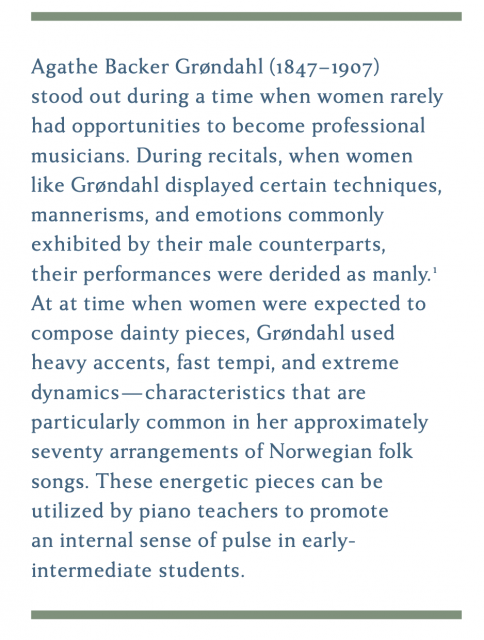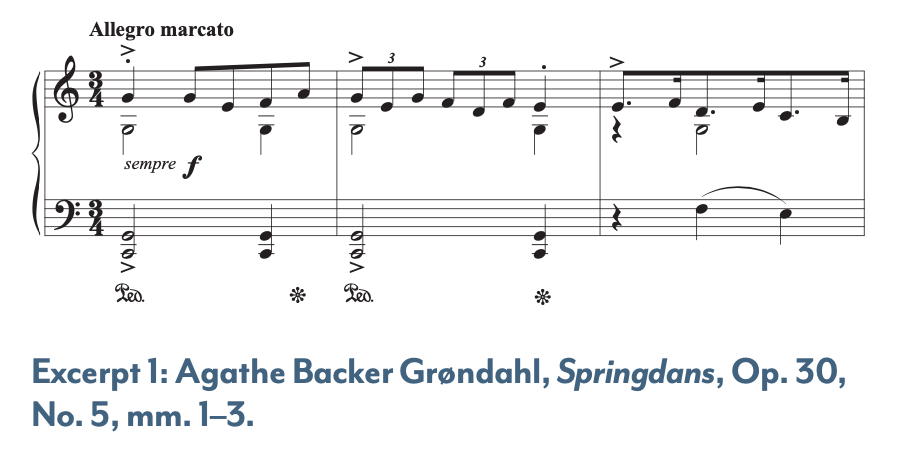We would like to thank Sarah Jenkins, our 2020 Collegiate Writing Contest Winner, for this insightful article on Norwegian folk songs. Are you a student interested in sharing your research and projects with the piano pedagogy community? On Friday, April 26th at 11am ET, the Frances Clark Center is hosting “Collegiate Connections,” an event to celebrate collegiate groups and their innovative projects. Learn more and submit a proposal, click here. The deadline is tomorrow, April 2nd!

Developing an internal sense of metric pulse and an understanding of subdivisions of beats is essential to the success of a young performer. Without establishing a strong sense of pulse, complex rhythms can be played incorrectly. This is too often a source of frustration for students—and teachers. By choosing repertoire where these aspects are highlighted and emphasized, students gain confidence in these areas of their musical training. Some of the standard teaching repertoire used for rhythmic development can be unappealing to students, due to a seemingly high level of difficulty or lack of interest in the character. The good news is these pieces do not have to be boring—they can be fun to learn and entertaining to play! Assigning pieces that have appealing melodies and fun character will motivate students to push through the potential rhythmic challenges. Two pieces by Agathe Backer Grøndahl, Springdans from Op. 30 and Halling from Op. 33, provide examples of how her arrangements of Norwegian folk songs offer students exciting tunes that also serve as exercises to promote rhythmic development.

Springdans, Op. 30 and Halling, Op. 33 are similar in many ways. They both offer students sources of metric pulse that allow them to further internalize the beat, and they both have lively and animated melodies. Because they are folk songs, each has a continuous, easy-to-follow melody throughout. These two pieces pair nicely together because they offer similar skills that are presented in different ways. Where Springdans offers a strong left-hand position and a grounding right-hand finger one as means for metric support, Halling contains sections that have an ostinato quarter-note pattern that is played primarily by finger five in the right hand. Students will be able to transfer the concepts learned in Springdans, where the supporting elements were more prominent, to Halling, where the rhythmic stabilizers require more sophisticated skill.

This springdans (leaping dance for men) is bouncy, fast, and rhythmically diverse. A forte dynamic marking and accented rhythms, combined with a melody that primarily uses steps and skips, create a fun and lively opening section. There are three distinct rhythmic patterns used throughout. These increase in complexity as the piece moves forward. Within the first three measures, the piece moves from a quarter note, to eighth notes, to triplets, to dotted-eighth sixteenths (see Excerpt 1).

A student might struggle with the juxtaposition of these rhythmic patterns. However, Grøndahl uses accented half-note and quarter-note accompaniment patterns to support the rhythmically complex melody. The open fifth in the left hand is commonly used in beginning method books and repertoire because it creates a strong, but comfortable, hand shape. In this piece the hand position is coupled with an accent—allowing for an overemphasized downbeat. The first finger in the right hand shares this accented rhythm, also giving the right hand a source of stability. Using fingers one and five, the right-hand octave downbeats also help create a strong hand position. Although playing multiple rhythmic subdivisions in succession can be challenging, students will find that the sources of rhythmic stability will help them in maintaining the metric pulse.
We hope you enjoyed this excerpt from Sarah Jenkin’s article, “Norwegian Folk Songs: Making Rhythmic Complexities Easy and Enjoyable.” To read the full article, click here.
More COllegiate Resources
- PIANO MAGAZINE: Collegiate Essay Winner: Emerging Adulthood and Undergraduate Group Piano by Melody Morrison
- COLLEGIATE CONNECTIONS: Calls for Proposals
- DISCOVERY PAGE: The Benefits of NCKP: The Piano Conference and Why You Should Attend by Marvin Blickenstaff
- COLLEGIATE RESOURCES
- MICROCOURSE: Teaching Collegiate Group Piano (from A Pianist’s Guide to Teaching in Groups)